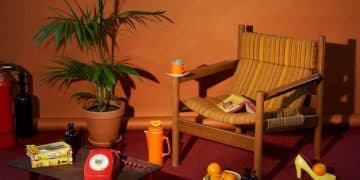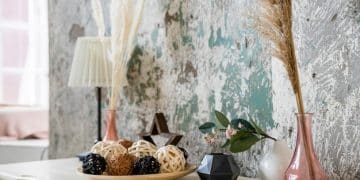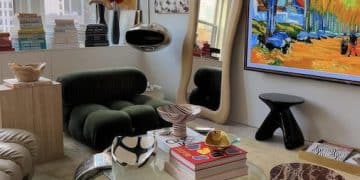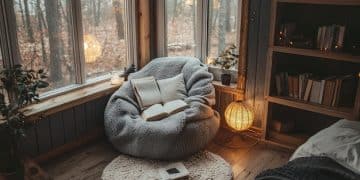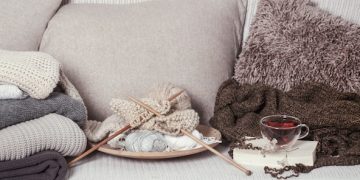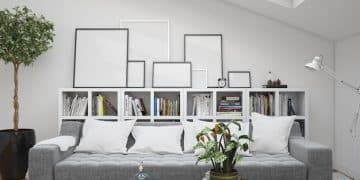The Art of Accessorizing: Interior Design’s Impactful Finishing Touches
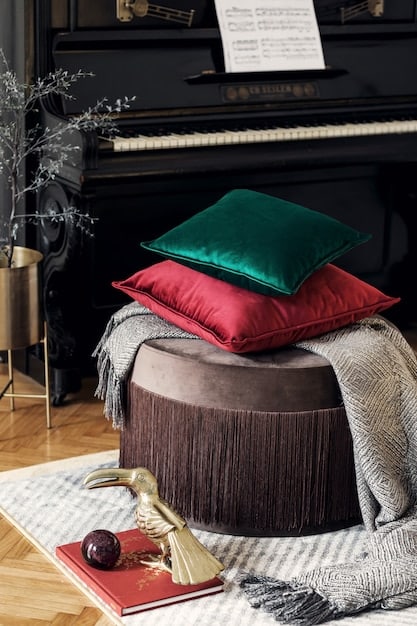
The art of accessorizing transforms interior spaces by adding personality and style through carefully selected items like pillows, artwork, and rugs, enhancing the overall aesthetic and creating a cohesive, visually appealing environment.
The art of accessorizing is often the most overlooked aspect of interior design, yet it’s the key to transforming a house into a home. It’s the layer that adds personality, warmth, and that all-important finishing touch that makes a space truly sing.
Why Accessorizing Matters in Interior Design
Many believe that accessorizing is merely decorative. However, when executed thoughtfully, accessories play a vital role that goes beyond aesthetics. They are essential to creating a space that feels complete and intentional, reflecting the homeowner’s taste and lifestyle.
Accessories can bridge the gap between furniture and architecture, creating a cohesive and harmonious environment. They add depth, visual interest and transform ordinary rooms into distinctive spaces.
Creating Visual Harmony
Accessories help to balance the overall look and feel of a room, preventing it from feeling sterile or impersonal. By carefully selecting items that complement the existing color palette, style and scale, you can create a sense of visual harmony.
Reflecting Personal Style
Accessories are a fantastic way to showcase your unique personality and interests. Whether it’s through artwork, travel souvenirs, or collections, each item acts as a conversation starter and personal touch that makes the space your own.
- Adding Texture and Warmth: Soft furnishings like throws, cushions, and rugs add layers of texture and warmth.
- Creating Focal Points: Strategically placed artwork or a striking mirror can draw the eye and establish a focal point in the room.
- Enhancing Functionality: Accessories like trays, baskets, and organizers not only look stylish but also enhance the functionality of a space.
In essence, accessorizing is the final step that brings all design elements together, transforming a house into a home that tells a story and reflects the lives of those who inhabit it.
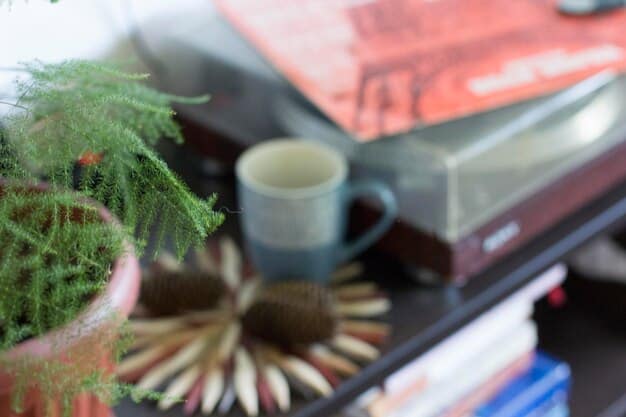
Key Elements of Successful Accessorizing
Effective accessorizing isn’t about haphazardly adding items; it requires thoughtfulness and a keen eye for detail. Several key elements contribute to a well-accessorized space that feels both stylish and cohesive.
Scale, proportion, color, texture, and personal style are all important considerations when choosing accessories for a room. Balancing these elements ensures a harmonious and visually appealing outcome.
Understanding Scale and Proportion
The size and placement of accessories should be in proportion to the furniture and the overall space. Oversized items can overwhelm a small room, while small accessories may get lost in a large area.
Color and Texture Coordination
Accessories provide an opportunity to introduce or enhance the existing color palette and texture. Choose colors that complement the room’s scheme and textures that add depth and interest.
Balancing Functionality and Aesthetics
While aesthetics are important, functionality should not be overlooked. Select accessories that enhance the usability of the space, such as storage baskets, trays, and lighting.
- Create a Mood Board: Gather inspiration and visualize how different accessories will work together.
- Start with a Focal Point: Begin by accessorizing the main focal point of the room, such as a fireplace mantel or a console table.
- Edit Ruthlessly: Avoid clutter by selecting only the most meaningful and impactful items.
By focusing on these key elements, you can create a space that feels curated, intentional, and uniquely yours. It’s about creating a visual narrative that speaks to your personality and complements the overall design of the room.
Choosing the Right Accessories for Each Room
Each room in a house serves a unique purpose and requires a different approach to accessorizing. What works in the living room may not be suitable for the bedroom or the kitchen. Adapting your strategy to the room’s function is essential for creating a cohesive and functional space.
Consider the purpose of each room and the type of activities that take place there. This will help you select accessories that not only look good but also enhance the usability and comfort of the space.
Living Room Accessories
The living room is often the focal point of the home, making it an ideal space to showcase your personal style. Consider items like throw pillows, blankets, coffee table books, and artwork that create a welcoming and stylish atmosphere.
Bedroom Accessories
The bedroom should be a sanctuary of relaxation. Soft textiles, calming colors, and personal touches like bedside lamps, scented candles, and framed photos can enhance the tranquility of the space.
Kitchen Accessories
While functionality is key in the kitchen, accessories can still add personality and style. Think about items like decorative canisters, cookbooks, utensil holders, and plants that brighten up the space.
Accessorizing appropriately for each room means understanding its function and how accessories can complement that function. Ultimately, the goal is to create a space that is not only visually appealing but also practical and comfortable.

Accessorizing with Art and Wall Decor
Art and wall decor are central in accessorizing a space. They add visual interest, reflect your personal style, and can completely transform the look and feel of a room. Wall decor can bring color, texture, and character to even the simplest of spaces.
Choosing the right art and wall decor involves considering the existing color scheme, the scale of the wall, and the room’s overall aesthetic. Whether it’s a bold statement piece or a gallery wall, the right choices can make a big impact.
Selecting the Right Art
Choose art pieces that resonate with you and reflect your interests, personality and taste. Consider the style, color palette, and size of the artwork in relation to the room.
Creating a Gallery Wall
A gallery wall is a collection of framed art, prints, photos, and other decorative items arranged on a wall. It’s a fantastic way to showcase multiple pieces and create a focal point. Plan the arrangement beforehand to ensure a cohesive look.
Wall Decor Alternatives
Beyond traditional art, consider other wall decor options like mirrors, tapestries, decorative plates, and floating shelves with plants. These add unique textures and visual interest to the space.
- Start with a Theme: Decide on a cohesive theme for your gallery wall, such as black and white photography or botanical prints.
- Mix and Match Frames: Use a combination of different frame styles and finishes to add visual interest.
- Consider Scale: Balance the size of the artwork with the size of the wall. Larger walls can handle bigger pieces, while smaller walls benefit from smaller arrangements.
Thoughtfully chosen art and wall decor can elevate the overall design of a room, adding personality, depth, and a sense of completion. It’s an opportunity to express your unique style and create a space that feels curated and personal.
Accessorizing with Textiles: Pillows, Throws, and Rugs
Textiles such as pillows, throws, and rugs are essential accessories that add warmth, texture, and color to any room. They have the power to transform a space from cold and sterile to cozy and inviting. The textures can significantly impact the overall comfort and appeal of an interior.
Choosing the right textiles requires considering the existing color scheme, the style of the furniture, and the desired level of comfort. Layering different textures and patterns can create a sense of depth and visual appeal.
The Power of Throw Pillows
Throw pillows are an easy way to add pops of color, texture, and pattern to sofas, chairs, and beds. Mix and match different sizes, shapes, and fabrics for a curated look.
Cozy Throws
Throws not only add visual interest but also provide warmth and comfort. Drape them over sofas, chairs, or beds for an inviting touch.
Rugs as Anchors
Rugs define spaces, add warmth, and tie together the overall design of a room. Choose the right size, color, and pattern to anchor the furniture and create a cohesive look.
- Mix and Match Textures: Combine different fabrics like velvet, linen, and knit for a tactile experience.
- Play with Patterns: Don’t be afraid to mix different patterns, but ensure they complement each other in color and scale.
- Consider Seasonal Changes: Swap out heavier textiles for lighter ones during warmer months to keep the space fresh and comfortable.
With thoughtful selection of pillows, throws, and rugs, you can significantly enhance the comfort and style of any interior. These textiles provide endless opportunities to personalize your space and create a warm, inviting atmosphere.
Accessorizing with Plants and Greenery
Introducing plants and greenery into your interior design brings life, color, and freshness to any space. Plants not only enhance the aesthetics but also improve air quality and create a calming, natural environment. Plants are often overlooked but add a lot of value.
Choosing the right plants depends on factors like the amount of natural light, the size of the room, and your level of commitment to plant care. Consider a variety of sizes, shapes, and textures for a dynamic and visually appealing display.
Selecting the Right Plants
Choose plants that thrive in your home’s conditions. Low-maintenance options like succulents, snake plants, and ZZ plants are great for beginners, while high-light plants can add a dramatic touch.
Creative Plant Displays
Experiment with different plant containers and arrangements. Group plants together for a lush, jungle-like feel, or display them individually in stylish pots and planters.
Faux Greenery Options
If you struggle with keeping live plants alive, high-quality faux greenery can provide the same visual benefits without the maintenance.
- Consider Natural Light: Place plants near windows to ensure they receive adequate sunlight.
- Use a Variety of Heights: Vary the height of your plants to create visual interest.
- Incorporate Hanging Plants: Hanging plants add vertical interest and save space.
Incorporating plants and greenery into your interior design is a simple yet effective way to enhance the beauty and well-being of your space. Whether you choose live plants or faux greenery, the addition of natural elements can transform a house into a home.
Accessorizing with Lighting
Lighting is a critical component of interior design, and accessories like lamps, sconces, and decorative light fixtures can significantly enhance the ambiance and functionality of a space. Good lighting is the design component that really sets the mood.
Choosing the right lighting accessories involves considering the room’s purpose, the existing decor, and the desired level of illumination. Layering different types of lighting can create a well-balanced and inviting atmosphere.
Types of Lighting
Ambient lighting provides overall illumination, task lighting focuses on specific areas, and accent lighting highlights architectural features or artwork. Combining these layers creates a dynamic lighting scheme.
Choosing the Right Fixtures
Select lamps, sconces, and pendant lights that complement the room’s style and color palette. Consider the size and shape of the fixtures in relation to the space.
Smart Lighting Solutions
Explore smart lighting options that allow you to control the brightness and color temperature of your lights. This can help you create different moods and conserve energy.
- Use Dimmers: Install dimmers to adjust the brightness of your lights for different activities and times of day.
- Consider Bulb Temperature: Choose warm white bulbs for a cozy atmosphere and cool white bulbs for a brighter, more energizing feel.
- Add Decorative Bulbs: Use vintage-style Edison bulbs in exposed fixtures for a unique aesthetic.
Thoughtful attention to lighting can transform the look and feel of any room, adding warmth, drama, and functionality. You can create a well-lit and inviting space that enhances the overall design and comfort of your home.
| Key Point | Brief Description |
|---|---|
| 💡 Visual Harmony | Balance your space with complementary accessories. |
| 🖼️ Art & Decor | Reflect your style with curated art and wall decor. |
| 🌿 Plants & Greenery | Add life and freshness with indoor plants. |
| 🛋️ Textiles | Enhance comfort with pillows, throws, and rugs. |
FAQ
▼
Accessorizing is crucial because it adds personality, completes the look of a room, and ties different elements together to create a cohesive and visually appealing space.
▼
Select items that reflect your personal style and complement the color scheme. Consider throw pillows, artwork, coffee table books, and rugs that add warmth and visual interest.
▼
Start with a focal point, mix and match frames for visual interest, and maintain a consistent theme. Consider the size of the wall and the placement of each piece to create a balanced arrangement.
▼
Choose plants that thrive in your home’s light conditions. Use a variety of heights and textures, and consider creative displays like hanging plants or grouped arrangements to add natural elements.
▼
Layered lighting is key. Combine ambient, task, and accent lighting to create a balanced atmosphere. Use dimmers to adjust brightness and choose fixtures that complement your style.
Conclusion
Mastering the art of accessorizing can truly transform your interior spaces, creating environments that reflect your personality, style, and attention to detail. By carefully considering the scale, color, texture, lighting, and personal touches, you can elevate your home from simply furnished to exquisitely styled.
